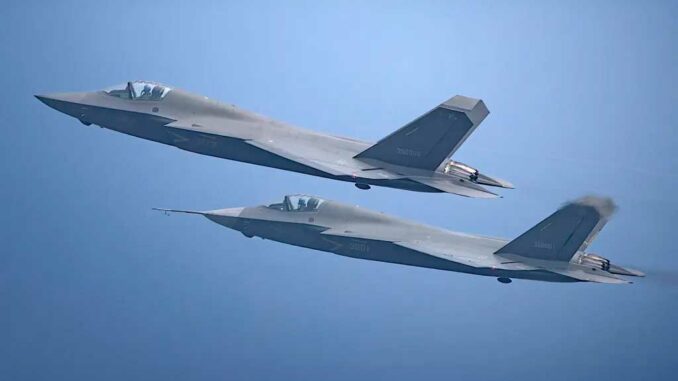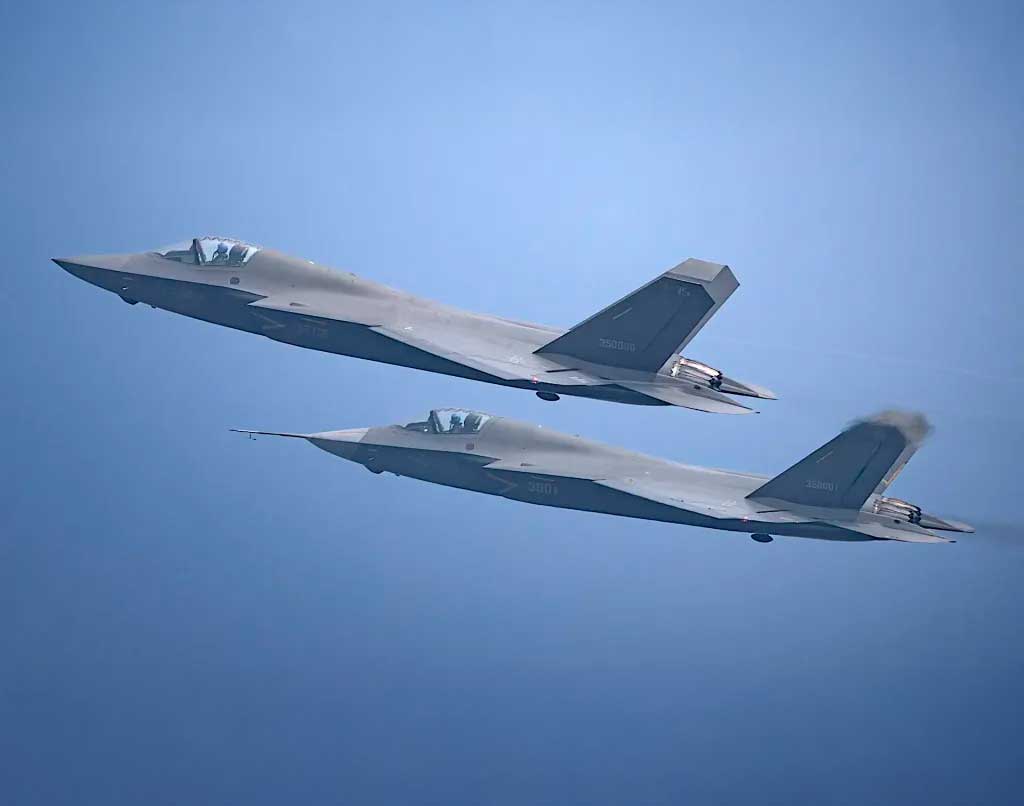
The Chinese J-35 enters initial production. This stealth fighter is expected to equip the Chinese navy’s catapult-launched aircraft carriers.
The J-35, developed by Shenyang Aircraft Corporation, is a new-generation stealth fighter designed to operate from Chinese aircraft carriers. Initially derived from the FC-31 program, it has been converted into a naval version for the PLAN (Chinese navy). Recent images suggest that two examples (0011 and 0012) have left the prototype phase and entered low-rate initial production (LRIP). This development comes as China is finalizing trials of its Type 003 Fujian aircraft carrier, equipped with electromagnetic catapults. The differences in engine power between the naval and land-based versions indicate that the WS-19 engine, currently under development, remains a critical component. The introduction of the J-35 into the navy would mark a significant advance in stealth air power in the Asia-Pacific region.
Initial production confirmed for Chinese naval J-35
The serial numbers 0011 and 0012, visible in an aerial photograph of two aircraft in formation, indicate that the J-35 has entered low-rate production. This phase, known as LRIP, allows for the production of a few units for testing in an operational environment and for logistical integration into the forces. It is a major technical step between prototype and series production.
The J-35 is the naval version of the FC-31, an aircraft originally designed for export. Since 2021, several prototypes have been spotted, including at least three distinct examples. These models were mainly used for flight testing, aerodynamic performance evaluation, and avionics system validation.
The presence of PLAN markings on the tail, including the shark symbol, as well as the pilots’ blue helmets, confirm that these aircraft are assigned to the naval aviation. In the absence of official communication, this publication suggests a strategy of controlled disclosure, probably aimed at demonstrating technological progress without revealing all the details of the doctrine of use.
This initial production run is also indicative of the rise of China’s military aviation industry, which is now capable of rapidly moving from prototype to pre-operational series production. In the short term, these aircraft will be used to train pilots in carrier landing, test onboard systems, and calibrate the infrastructure of the Type 003 Fujian aircraft carrier.
Expected integration on the Type 003 Fujian aircraft carrier
The Fujian, China’s third aircraft carrier, is the first to be equipped with electromagnetic catapults (EMALS). This system, which is more efficient than traditional ramps (STOBAR), allows heavier aircraft to be launched at full load with a reduced launch cycle. The J-35 was designed to exploit this potential.
Cross-checked sources suggest that sea trials have already taken place, although independent imaging confirmation is still lacking. However, industrial logic and historical precedents (e.g., the sudden deployment of the J-15B) make this hypothesis likely. The Wuhan shipboard test center, with its runways simulating an aircraft carrier deck, has already been used to train pilots and technicians in the operation of CATOBAR aircraft.
The J-35 could be one of the first operational stealth fighters catapulted from the Fujian, a role previously filled only by modernized versions of the J-15. The introduction of a stealth aircraft in this context will require adjustments to airborne air control systems, at-sea failure management, and power projection strategies.
Compatibility with electromagnetic catapults is a strong indicator of China’s desire to project its naval power beyond the South China Sea. By equipping its fleet with a stealth aircraft suitable for modern air combat, it is closing in on the operational capabilities of the US Navy, particularly with the F-35C.
Differences in engine power between naval and land versions
A major technical issue concerns the J-35’s engine. The naval version currently being tested appears to be equipped with the WS-21, an evolution of the WS-13, identifiable by its lighter nozzles. However, the land-based J-35A version may already be using the WS-19, a fifth-generation engine currently under development, whose darker nozzles are visible in some photos.
The WS-21 provides approximately 95 kN of thrust with afterburner, while the WS-19 is said to target 110 to 120 kN. This improvement would enable supersonic flight without afterburner, a key factor for thermal stealth and reduced fuel consumption. Supercruise also improves tactical responsiveness in contested areas.
The introduction of the WS-19 in the shipborne version has not yet been confirmed. This engine poses several challenges: thermal management, longevity, and safety in a saline environment. Deployment on an aircraft carrier imposes increased reliability standards, as any failure could compromise the aircraft during the critical landing phase.
The dual engine configuration for the land and naval versions complicates logistical support but offers flexibility in development. It also allows the industry to continue testing the WS-19 without delaying the integration of the J-35 into the navy, by focusing on a gradual evolution of the fleet.

A fifth-generation stealth fighter: design and capabilities
The J-35 meets the technical specifications of a fifth-generation fighter, with an architecture designed to reduce its radar, thermal, and acoustic signature. It features:
- An AESA radar integrated into the nose (type unknown, probably equivalent to the KLJ-7A),
- A cell designed without protruding edges, with S-shaped air intakes to mask the compressor,
- Fairing-covered movable surfaces and the use of radar-absorbing coating,
- Internal bays capable of carrying 4 to 6 missiles or bombs without external signature,
- An IRST sensor for passive detection of thermal threats.
In terms of dimensions, the J-35 is comparable to the F-35C: approximately 17 m long, 11.5 m wingspan, with an estimated maximum takeoff weight of 25,000 kg. Its range with internal fuel tanks could reach 1,200 to 1,500 km, extendable via in-flight refueling.
It can be integrated into a networked warfare architecture via tactical data links, enabling real-time coordination with drones or airborne early warning aircraft (such as the KJ-600). It could thus form the centerpiece of a stealth carrier air wing, including early warning aircraft, armed drones, and multirole fighters.
The modularity of the weapon system, connectivity, and stealth capabilities position the J-35 as an advanced deterrent, capable of neutralizing air, land, or naval threats in the first minutes of a maritime conflict.
A strategic rise for the Chinese navy
With the J-35, the Chinese navy has reached a structural milestone. It now has a fifth-generation carrier-based fighter capable of partially rivaling the US F-35C. This capability comes at a time of growing rivalries in the South China Sea and accelerated naval expansion.
The simultaneous presence of two stealth fighters (J-20 and J-35) shows that China now has the necessary technological building blocks: stealth airframe, AESA radar, indigenous engines, and integrated electronic warfare. This plurality strengthens its ability to distribute threats geographically.
The Fujian aircraft carrier is a force multiplier. Combined with the J-35, it gives Beijing a means of projection beyond the first island arc. However, operational proficiency will depend on the pace of industrialization, the reliability of supply chains, and the ability to train pilots.
In this technological race, the challenge for China no longer lies solely in copying Western equipment, but in its systemic integration, tactical use, and adaptation to naval doctrine. The current structure suggests that this ambition is now realistic.
War Wings Daily is an independant magazine.